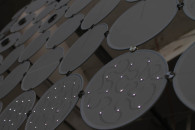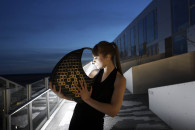A Danish design firm rethinks how responsive textiles can adapt to context, moods or environmental changes.
by Michel Guglielmi, co-founder, Diffus Design
Diffus has always been committed to combining theory and practice. The success of combining research and experimentation soon implied that we had to extend our activities and get involved in the making of design alongside the discussion of theory. Still today, our conceptual and theoretical approach to design and to pragmatic solutions is our main asset. We are known for projects, which often involve technologies rarely used in the realm of design, and for a unique combination of traditional craft and new technology, sensuality and digitality.
We find the relationship between digitality and materiality inspirational. The mix of digital and physical materials results in unique hybrid materials in its own right that epitomizes today’s “zeitgeist.” We are, for example, interested in the possibility of merging soft circuitry with IT-technology and craft to create completely new experiences in textile applications.
Concerning the interactive parts of our projects, we are interested in the possibility of imagining responsive textiles and garments that adapt to context, moods or environmental changes. Such materials now have the potential to reflect changing emotions and become an interface between the body and the world around us. The applied textiles surface becomes a means for storytelling.
Light, sound and scent
One project which may illustrate our design philosophy and our aspirations is Wall-E(motion), a modular system of textile discs that have been embroidered with conductive yarn to generate sensory outputs including light, sound and scent, across a custom-made surface. The system can be used as a window curtain, a room divider, a sound installation and a light source. Sensory textile discs can be added, removed or re-configured to change the final layout.

Currently, we propose a basic set of disc-functionalities. But the modular system will provide an opportunity for new patterns and sensory functions to be added along the way, as new applications emerge from Labs and technologies such as OLED, printed responsive surfaces, piezoelectric fibers and other exciting materials are developed and their performance optimized. Wall-E(motion) is therefore a product available on the market and at the same time our “playground” for ongoing experimentations.
One could argue that modern appliances are increasingly collected as design objects within the home, accepted and celebrated as a necessary evil for modern life. But Wall-E(motion) takes another approach by creating an easily transformable and configurable system of appliances able to contain all those different functionalities within a networked array of soft, repetitive disks, which act as smart power and information hubs. Individual appliances are transformed into an organic network with interrelated functionalities that is also appealing to our senses.

 In the daytime hours one hundred small solar power stations distributed on The Solar Handbag generate enough electricity to charge a mobile device and a lithium ion battery hidden inside. At night, opening the bag activates optical fibers inside that give enough light to find keys or another object of importance.
In the daytime hours one hundred small solar power stations distributed on The Solar Handbag generate enough electricity to charge a mobile device and a lithium ion battery hidden inside. At night, opening the bag activates optical fibers inside that give enough light to find keys or another object of importance.On the agenda
In the near future, we will keep working with new composite materials to explore their potential for innovative design solutions. Some of the topics on our agenda that will be explored in collaboration with a range of the most innovative research labs in Europe are:
- Embroidered solar cells (See the company’s “High fashion and highly functional” “Eclipse” project.)
- Printed circuits, printed solar cells and printed batteries
- Piezoelectric composite fibers and surfaces to create an integrated material together with printed batteries insuring harvesting, storage and transport of energy within the fabric
- Integrating washable and waterproof light patterns into textiles
A recurrent phenomenon for us is therefore energy harvesting, which is the process by which energy is extracted from the environment, then converted and stored. Solar energy has been an obvious choice, but our recent work has revealed the possibilities of piezoelectric materials. They have been used to convert mechanical movement and vibrations into electrical energy through their inherent piezoelectric effect. In the area of wearables, this mechanical energy could, for example, be raindrops, wind or friction from human motion. Until now, results show voltage outputs up to 6 V, which is considered enough for potential applications in powering wearable micro systems.
Mobility and independence in modern life, combined with awareness of renewable energy, will increase demand for energy harvesting devices on many different scales. We believe that we have only seen the “tip of the iceberg” in this development, and we look forward to the exciting challenges and possibilities it will bring.
Diffus Design APS, Copenhagen, Denmark, was created in about 2002 as an academic collaboration between art historian Hanne-Louise Johannesen and architect Michel Guglielmi, who works with tangible media and interaction design and teaches at the Royal Danish Academy of Fine Art, Schools of Architecture and Design.
 TEXTILES.ORG
TEXTILES.ORG


